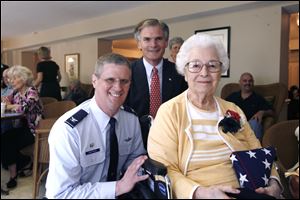
Local woman honored for WWII service as pilot
5/1/2010
Col. Mark Bartman, commander of the 180th Fighter Wing, left, and Rep. Bob Latta present Leona 'Le' Zimmer, 89, with a Congressional Gold Medal for her service during World War II.
In a 1940s-era photo, a young Leona Golbinec poses with hands tucked in desert khaki pants and a bomber jacket casually opened like the cool pilots of the day.
In another, she stands in sleek black pants and pilot's leather cap as she reaches up to touch a plane's still propeller.
The photos, strewn about a rest home window sill, tell of adventures that took the young pilot around the globe.
The 89-year-old, who likes to be called Le, is a piece of living history, one of about 1,000 female pilots who served during World War II. She would later marry and become Leona Zimmer and travel the world, seeking adventure.
The female pilots, called WASPs for Women's Airforce Service Pilots, did not see combat, but were domestic test pilots and delivered planes. It was dangerous work, and 38 died.
She smiled broadly yesterday as U.S. Rep. Bob Latta (R., Bowling Green) thanked her for her service. He handed her a Congressional Gold Medal, folded American flag, and a certificate. She couldn't make the March 10 ceremony in Washington honoring WASPs because of her health.
At times yesterday, she couldn't speak clearly, a recent stroke robbed her of some of her ability to speak. But she could see and understand, and communicated well enough that her father, back in the 1940s, didn't approve of her choice to pilot airplanes. It wasn't ladylike, he said.
But her two brothers were military pilots, and one of them taught her, she said.
To prepare, the female pilots underwent intensive training. Some failed or dropped out. Of the 25,000 applicants, only 1,075 were certified. The WASPs didn't fly outside the United States. But they delivered planes to and from factories and air fields.
"As WASPs, we weren't allowed in combat or permitted to fly outside the United States," she told The Blade about 15 years ago. "Ironically, some of us were allowed to test aircraft which had been rebuilt after male pilots cracked them up, or to make certain that a plane was safe for a male pilot to fly. We didn't consider this fair."
Despite the exploits of Amelia Earhart, whose plane disappeared in 1937, gender inequities persisted in the 1940s skies.
"The worst of it was that we weren't recognized as military pilots and had no insurance or other special rights," she said previously. "When women pilots died, we used a special fund we raised ourselves to send the bodies to their hometowns. It was unjust, but the brass didn't want women in the military."
She returned to Rossford after the war to teach school, but moved to Hawaii to be a teacher there. She later traveled to Venezuela, where she taught students at an oil company camp and met her husband, William Zimmer, an engineer from Michigan.
The couple moved on to Argentina, where Mr. Zimmer died in 1966 from exposure to natural gas because of a broken heater in their home. Leona was in Ohio visiting family.
Eleven years later, Congress recognized the WASP pilots as official military veterans. That same year, 1977, the Air Force graduated its first official class of female military pilots.
Mrs. Zimmer worked for Lucas County, and found her way later in life to Perrysburg Commons.
Contact Christopher D.
Kirkpatrick at:
ckirkpatrick@theblade.com
or 419-724-6134.